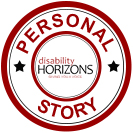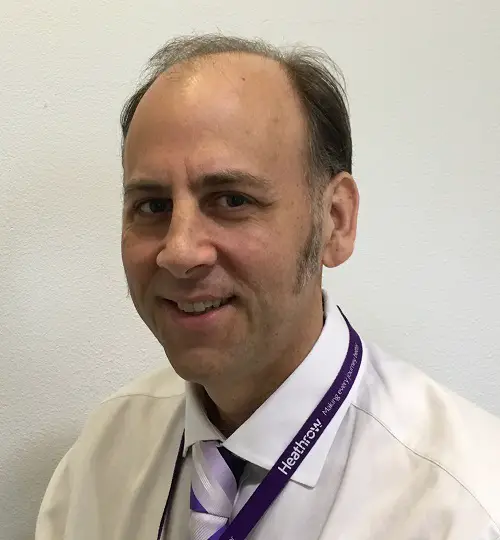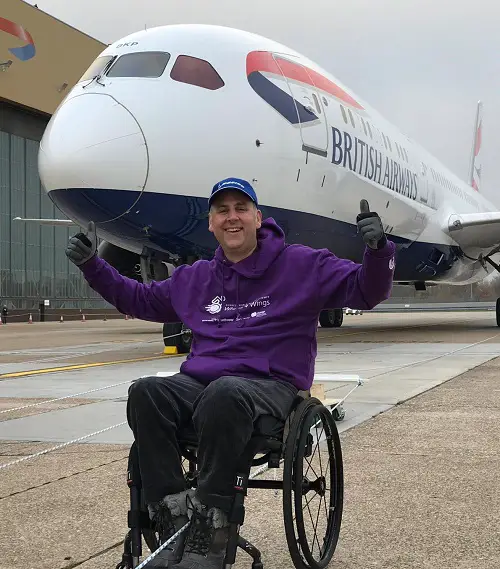
Learning to fly again after a spinal injury
Wheelchair user Andy Knight hasn’t always been disabled. He used to be a pilot, but after a spinal injury, his career and life took a different turn. Years on, he’s remained in the aviation industry, now working for Heathrow as an Aircraft Operations Manager. Here he talks about his injury, how he came to terms with his new disability and retraining. Plus, read his top tips for anyone flying with a disability.
 I was born in New Zealand and grew up there. From as early as I can remember, I was obsessed with flying. As a child I looked at birds with envious fascination, it didn’t seem fair that they could take to the wing whenever they wanted to, and I couldn’t.
I was born in New Zealand and grew up there. From as early as I can remember, I was obsessed with flying. As a child I looked at birds with envious fascination, it didn’t seem fair that they could take to the wing whenever they wanted to, and I couldn’t.
I flew solo for the first time at 16, then gained my private pilot licence at 17. Going beyond that stage is financially challenging and it took me a few more years to collect the necessary professional qualifications to begin working as a pilot. I started out in my first flying job as a flying instructor in my early twenties.
The aviation industry, career-wise, is notoriously slow in New Zealand. As my father is English, born in London, I was entitled to become a British citizen. So I decided that adventure, fortune and a glamorous flying career awaited me on the other side of the world.
When I arrived in the UK I had to sit more than a dozen aviation examinations – my New Zealand licence wasn’t recognised here. I finally got through them and the final hurdle was to complete some flight training to prepare for a practical flying test. But, before that, I decided to take a short break and visit New Zealand for a friend’s wedding. I never made it. I ended up in hospital in Singapore instead.
Becoming suddenly ill
At the airport, I found it a little difficult to walk, but I didn’t think much of it (I’d had food poisoning just before). During the flight, I found it difficult to undo buttons and zips on my clothing, and even harder to do them up again.
During my stopover in Singapore, I was struggling to walk more than 100 metres without needing to sit down and I found it hard to hold a pen and even press the buttons on my mobile phone. The next day I saw a doctor and before I knew it I was seeing a neurologist who admitted me to hospital after an MRI scan.
As it was clear I would need a number of tests, my travel insurance company brought me back to the UK – the medical bills in Singapore were astronomical. I was eventually diagnosed at Charing Cross Hospital with ependymoma, a rare form of cancer that affects the spine and the brain. It’s usually one or the other; in my case, it was both.
I had a tumour the size and shape of my little finger attached to my spinal cord and another that resembled a lettuce leaf had spread through the occipital lobe in the base of my brain. At the time I was in a daze, I didn’t really take it all in. I was told that both tumours were benign, but that the one in my spine needed to be removed and the other treated with radiotherapy.
But, after waking up from surgery, I soon figured out that I couldn’t move my legs or feel anything below the level of my chest. I had suffered a spinal cord injury during surgery.

Learning to live with a spinal cord injury
It took a long time to recover because of other complications, so I was there for months and became very depressed. I was completely dependent on nurses and doctors for absolutely everything – moving, bathing, dressing, and eating. I couldn’t even hold a knife and fork and remain sitting upright unassisted.
Once radiotherapy was completed, I was transferred to the National Spinal Injuries Centre at Stoke Mandeville. By the time I left there, it was clear that I was going to be paraplegic and a wheelchair user for the rest of my life. Despite hours of physiotherapy and various other treatments, the damage done to my spinal cord was simply too much. I could no longer stand or walk.
By now I had spent 14 months in hospital, I was institutionalised, dependent on others, and angry. It took me a good couple of years to snap out of it.
I eventually figured out there was a simple choice between sitting around doing nothing and feeling sorry for myself, or picking myself up and doing something positive with my life. I discovered that feeling intentionally miserable every day consumed a huge amount of energy. Why not put that energy into something useful?
Returning to aviation
I didn’t ever think I’d return to aviation. But then I heard about an organisation called Flying Scholarships for Disabled People. It didn’t even occur to me that it might be possible to fly again, or that such opportunities for disabled people existed.
I was very lucky to get through the application and recruitment process, luckier still to be sent to a flying school in South Africa for six weeks, fully funded. It was an amazing experience.
Due to my background, I was able to gain a full Private Pilot Licence with the allotted grant. I had several incredible flights, unaccompanied in a small four-seater aircraft, discovering the huge African landscape and coastline.
When I returned to the UK, my head was in a completely different place. I knew I wouldn’t be able to go back to commercial flying, but I realised that I could still fly recreationally if I wanted to – but more importantly – I could basically do anything I wanted to if I turned my mind to it. It was a huge confidence boost.
I also realised that aviation was still a powerful mistress and her siren song was hard to ignore. I applied to become an air traffic controller but didn’t make it through the selection process. So I enrolled in an aviation business management course at university.
After university, I soon found a place with an aviation consultancy firm, where I spent four years. But I still missed the action of the aviation environment. By chance, I was sent by my company to work temporarily at Heathrow Airport. While there, I decided it was the place for me. My desk was near the window with the constant drama of millions of passengers arriving and departing right in front of me.
I was very lucky that a vacancy existed with Heathrow, suitable for my background and the skills I had recently developed. I have now been there for just over six years
I currently lead a team of approximately 30 people in the Airport Operations Centre, ensuring that aircraft arrive and depart as punctually as possible and have somewhere to park while they’re here – sounds easy but it isn’t!

Insider tips for disabled travellers
1. Make sure you notify the airline that you require special assistance at least 48 hours prior to travel. This is a legal requirement – if you don’t let them know you need help then you may not receive it. Obviously, it’s best to let them know as early as possible, preferably at the time of booking.
2. With some airlines, such as British Airways, you don’t need to book assistance separately every time you fly with them. I have a booking profile with BA that stores information about the type, size and weight of my wheelchair. It also shows what level of assistance I need. Using industry-recognised service booking codes, it knows I am WCHC – a wheelchair user who cannot stand or walk.
During online booking it simply asks me to verify the information is still correct and it automatically arranges the correct service to help me board the aircraft. It also removes the restriction to pay extra to pre-select a seat. As a wheelchair user, I prefer to sit by a window so I’m not blocking other passengers.
3. Under European law, it’s the airport that provides special assistance, not the airline. At Heathrow, this is provided by a third-party. I always go to the special assistance desk with my boarding pass after checking in and let them know I’ve arrived. On some occasions, when I’ve proceeded directly to the gate they haven’t shown up to help me. So I like to double check.
4. Airlines prefer to board disabled passengers first, along with families travelling with young children and anyone else needing assistance. Try to arrive at the gate early and ask the staff if you can ‘pre-board’. This means that they check your passport and boarding pass and bring you through into a waiting area closer to the aircraft. Then you can board quickly and easily when they’re ready and get settled into your seat while everyone else boards after you.
5. If you’re a wheelchair user and, like me, you can’t stand or walk, the special assistance staff will need to use an ‘aisle chair’ to help you board. It is a narrow wheelchair with small wheels that fits along the narrow walkways between the seats on the aircraft. Different types are used at different airports.
You will need to transfer out of your own chair into the aisle chair. At Heathrow, there are currently two types used: the ‘Columbia’ and the ‘Staxi’. I prefer the Columbia as it is smaller in length (front to rear) so easier to manoeuvre in tight spaces. It also has fold-down armrests that make transfers easier.
6. Always ask the special assistance staff to use all the safety straps on the aisle chair. Sometimes they might only use one (or none!) and think that is OK. If you have poor sitting balance like me, being fully strapped in and secure gives you more peace of mind. It’s not much fun tipping out of the chair and then being picked up off the floor!
7. When arriving at Heathrow, there is a special fast-track lane for wheelchair users and those needing assistance in immigration. The waiting time is usually shorter than the lanes used by other passengers. Look out for the universal wheelchair symbol. If you’re travelling as part of a group, then it’s OK for them to accompany you in that lane. Wheelchair users can’t use the electronic gates (yet).
By Andy Knight
More on Disability Horizons…